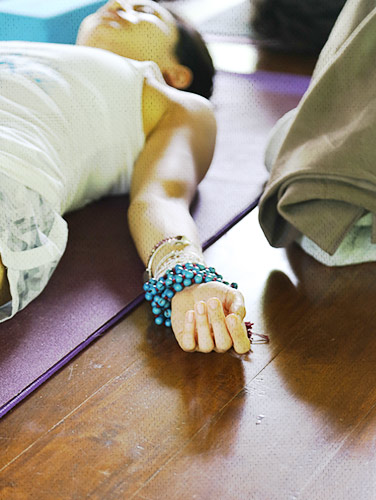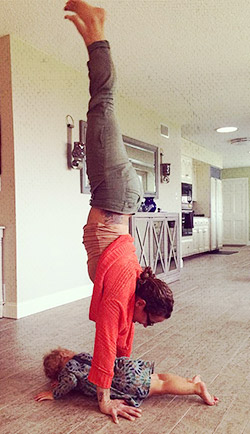A lifelong love of yoga is like a relationship. You’ve got the good times, many of which tend to happen in the beginning, and you’ve got the…less good times. If you are a devoted yogi and, especially if you are a teacher, you have probably wrestled with burnout. If you haven’t—well, give it time. Those of us who teach have to worry not only about tending our own yoga fire, but keeping it burning brightly enough to illuminate the way for our students. There is some inherent responsibility and pressure in the teaching role, and that can either work for or against us where burnout is concerned. Here are some potential causes of yoga burnout, and what to do about them.

1. We are teaching through a self-care deficit. This is by far the most common cause of burnout for yoga teachers everywhere. After all, it’s not easy to make your living solely from teaching yoga—ergo, you’ve either got a day job or you are doing some major hustling to make ends meet. Show me a yoga teacher who has never skipped breakfast or had a 10:00 p.m. dinner, and I will show you a very new yoga teacher. The result of our crazy schedules can be that we are simply not rested enough or calm enough to teach from our center. We can begin to feel resentful of our classes, since we might perceive them as the thing standing between us and our goal of going home and passing out on the couch. We might even start to feel like frauds, since we are hardly practicing what we preach.
So, what do we do about this? Well, no one answer will fit for everyone, but there are a couple of good places to start. A good first step is to ask ourselves what is driving our go-go-go mentality. Is it that we are genuinely so tight on funds that we don’t feel we have the option to do less? If so, then we need to have a serious talk with ourselves about how much we are charging for our services. As helpers, we may want to cut people breaks on private lessons when we shouldn’t, or feel completely at the mercy of others who determine our pay rate for us. We are in business for ourselves, so it’s imperative that we remember our own negotiating power. We have the right to be paid what we’re worth.
Sometimes, though, our issue is not that we have no wiggle room in terms of finances, but that we haven’t worked through our money issues. Most of us have some long-held beliefs and/or emotions that have the potential to really bog us down where money is concerned. If that is the case for you, you may want to consider seeing a therapist or money management coach who can help you work through that stuff.
Another barrier to getting enough self-care time is simple, good old-fashioned people pleasing. Maybe someone asks you to cover their 7:00 a.m. class, even though you are so not a morning person and will have to teach an 8:00 p.m. the night before. If you are guilty of saying yes to this sort of request through a teeth-gritting smile, consider the following: dragging your exhausted, irritated self to that class is very unlikely to result in a great yoga experience for students. It will, though, lead to more burnout for you, and a nice hefty chunk of resentment for the person who simply asked you for a hand. When we learn to work our “no” muscle, everyone wins in the long run.

“As far as teaching, I have learned in some hard ways that you cannot pour from an empty cup. Being deeply rooted in a sensible, consistent, meaningful personal practice keeps whatever teachings I am communicating relevant and purposeful to students. My own practice has changed drastically over the years, and that is why I explain it as “sensible.” I think with social media, and particularly our modern yoga culture on social media being so prominent, it’s easy to convince yourself that you’re not worthy because you’re not in India chanting on the streets or handstanding on a beautiful beach in Costa Rica. These days, with three jobs and two young children at home, my practice has to work in my own life, or else it means nothing. I always encourage students of mine to start small. Five minutes a day of something sustainable. Instead of pulling ideas off of the Internet (which is a great idea at certain times), how about drawing from your own experience?! If I’m authentic, I don’t have to be super original. It’s my own because it’s my own.
Also, when I was a newer teacher, I spread myself thin. I over-committed. I didn’t know how to say no. Almost seven years later, I teach one class per week, and have noticed a distinct difference in the quality of what is offered. Even though my physical practice may not be what it used to because of time and post-baby bearing bodily changes.”
~ Samantha Fulton
Teacher, Tadasana – Life in Balance Yoga Studio
Fishkill, New York
2. We neglect our personal practice. Yoga teachers tend to fall into one of two camps: the folks who faithfully practice three or more times per week, and the folks who…don’t. If you are in the latter camp, I promise—it is okay. The first challenge you can set for yourself to do is let go of your shame around not being a perfect yogi. The next step is to figure out how much yoga is necessary and beneficial for you in a given week. We are all different—our bodies, minds, and spirits have varying needs. If you would love to be doing your practice four times per week and you know it would make you a better, more energized teacher, then you can work up to that gradually. If twice a week is enough for you to feel engaged and inspired in your practice, then work on being okay with that. If you need (or want) to practice everyday, maybe you decide to flow for 20 minutes and meditate for 10. Make it work for you instead of forcing yourself into a poorly fitting mold. Above all—have compassion for yourself if you have an off-week.

“I definitely go through times where I’m just tired of teaching and hearing my own voice, but generally I ward that off by staying inspired and passionate, and I stay inspired and passionate by reading and researching. When I’m researching something I will often be led to a topic I know little about and it ignites my interest. I find that this practice is endless learning, which is one thing I love about it. I also find just flicking through different Yoga Sutra or Bhagavad Gita texts will bring me to something that is valid in my life at that time, and I feel if it is valid for me, it is valid for others. Another way is stories, I love the stories of different deities and bringing them to life in class and relating these stories that were written thousands of years ago to our lives now. Also continuing my training and taking classes, workshops, and trainings with inspiring teachers always refreshes my love and commitment to this practice, and the time away from teaching and just being a student, to me is really important—it reminds me why I got hooked on this practice and why I decided to teach.”
~ Susannah Grange
Owner, Hudson River Yoga
Poughkeepsie, NY
3. We are bored. Teaching yoga is equal parts art and science. So, like all good artists, we need fresh inspiration regularly. Like all good scientists, we need to learn constantly in order to stay relevant. A hike, a good book, some Desikachar on YouTube, or a brand spankin’ new playlist always does it for me where inspiration is concerned. With regard to learning, a wise teacher once told me, “You can always tell a yoga teacher who doesn’t go to anyone else’s classes.” She was right. It’s not enough to do our own practice, although that is important too. We must, must, must see what else is out there—and regularly. Even when you’re in the zone teaching-wise, you will never regret going to a workshop, visiting a new studio, or splurging on a retreat. In fact, you’re guaranteed to return to your own teaching fresh and full of new ideas.
4. We have not caught up to ourselves. Sometimes, no matter what we do, our teaching does not seem to want to snap back into what it once was. If this is the case, it’s a good idea to ask ourselves whether there is a disconnect between how we’ve been practicing and how we’ve been teaching. Things happen in life—and sometimes, those things trigger a change in the way we live our yoga. For example, let’s say you are a vinyasa teacher who loves a sweaty flow with lots of floating, inversions—the works. Then, one day, you become injured or receive a life-changing diagnosis. Suddenly, you find that a fast flow feels draining and torturous, but a slow, deep yin practice recharges your batteries. If you’ve made this kind of long-term change in your practice, does it make sense to keep teaching a practice you no longer do? If you need or want to make a change in your practice or your teaching, remind yourself that you are allowed to do that—it’s not a failure or a cop out. In fact, it is an excellent way to practice vairagya (non-attachment) and ahimsa (non-harming).

“When I experience burnout, I know that it is time for more svadhyaya, or self study. Once I sit and go inside and evaluate my relationship with myself or the source, I am usually able to find that there is a certain amount of creativity lacking in one way or another. This can be on my canvas, on my mat, or even philosophically. What new thoughts or theories am I forming? How am I living? and how am I sharing this study, life, and reflection with my students?
It is never really the yoga or the teaching that I doubt. As this inner work, learning to love, and sharing that love is what life’s all about—It is usually more an obstacle of how I am allocating my time. How can I carve out time to create something for myself and students so that we can all come in contact with ourselves, our universal consciousness, our love.”
~ Suzanne June Martin
Teacher, Heartspace Yoga and Healing Arts, Troy, New York
The Hot Yoga Spot, Albany, New York
I hope these ideas are helpful to you in your yoga journey. Remember that, like all relationships, the one we have with our yoga teaching has natural ebbs and flows. It’s okay to recognize that, and give ourselves permission to make changes. When we allow our yoga to change with us—to support our needs rather than constrain us—we help to ensure that we’ll never want to throw in the towel for good.
